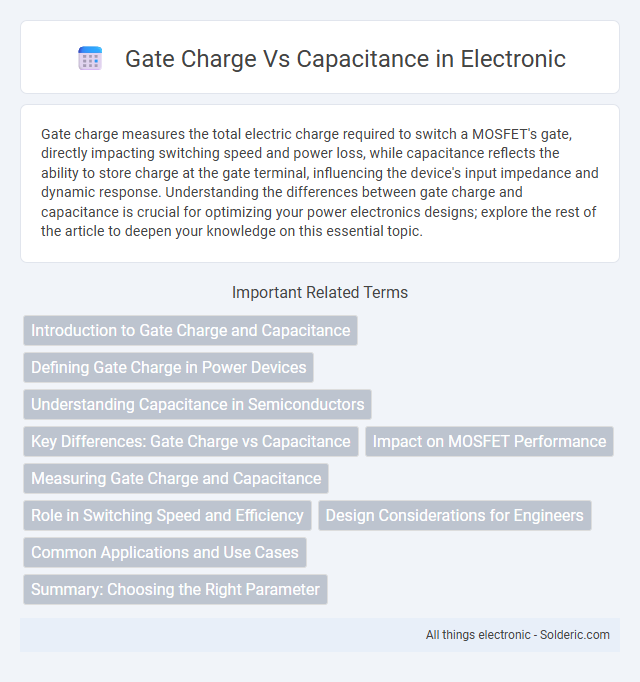Gate charge measures the total electric charge required to switch a MOSFET's gate, directly impacting switching speed and power loss, while capacitance reflects the ability to store charge at the gate terminal, influencing the device's input impedance and dynamic response. Understanding the differences between gate charge and capacitance is crucial for optimizing your power electronics designs; explore the rest of the article to deepen your knowledge on this essential topic.
Comparison Table
| Aspect | Gate Charge | Capacitance |
|---|---|---|
| Definition | Total charge required to switch the MOSFET gate | Ability to store charge, ratio of charge to voltage (Q/V) |
| Units | Coulombs (C), often nano or microcoulombs | Farads (F), often pico or nanofarads |
| Measurement | Measured by integrating gate current over switching time | Measured as capacitance between gate and source/drain terminals |
| Role in Switching | Directly affects switching speed and gate drive power | Determines transient response and delay |
| Usage | Used for estimating gate drive loss and switching energy | Used for AC analysis and frequency response |
| Related Parameters | Qg (Total gate charge), Qgs, Qgd | Cgs (Gate-source capacitance), Cgd (Gate-drain capacitance) |
Introduction to Gate Charge and Capacitance
Gate charge represents the total charge required to switch a MOSFET's gate voltage, directly impacting switching speed and power efficiency, while capacitance refers to the MOSFET's inherent gate-to-source and gate-to-drain capacitances influencing transient response. Understanding the relationship between gate charge and capacitance is essential for optimizing device performance, as capacitance values determine the charge accumulation and discharge rates during switching events. Accurate assessment of these parameters enables improved design of power electronics circuits by minimizing switching losses and enhancing overall efficiency.
Defining Gate Charge in Power Devices
Gate charge in power devices quantifies the total electric charge required to switch the device from off to on, directly influencing switching speed and efficiency. Unlike capacitance, which measures the ability to store charge at a fixed voltage, gate charge accounts for the dynamic charge transfer during gate voltage transitions in MOSFETs and IGBTs. Optimizing gate charge is crucial for reducing switching losses and improving the overall performance of power electronics modules.
Understanding Capacitance in Semiconductors
Gate charge is directly influenced by the capacitance of a semiconductor, which represents its ability to store and hold electric charge within the device. Capacitance in semiconductors is mainly determined by the physical structure and the dielectric properties of the insulating layers, affecting the switching speed and power efficiency of transistors. Understanding gate capacitance helps you optimize device performance by controlling charge storage and minimizing delay in electronic circuits.
Key Differences: Gate Charge vs Capacitance
Gate charge represents the total electric charge required to switch a MOSFET gate from off to on, measured in coulombs, and directly impacts switching speed and energy loss during transitions. Capacitance, expressed in farads, defines the MOSFET gate's ability to store charge at a given voltage, influencing how the gate voltage changes with applied charge. Unlike capacitance, which is a static parameter describing charge storage capability, gate charge quantifies the dynamic charge transfer involved in the switching operation, making it a critical factor for driver design and efficiency optimization.
Impact on MOSFET Performance
Gate charge and capacitance are critical parameters affecting MOSFET switching performance, directly influencing switching speed and energy losses. Higher gate capacitance increases gate charge, leading to slower switching times and greater power dissipation in high-frequency applications. Optimizing the gate charge and capacitance balance enhances efficiency and thermal management in power electronic circuits.
Measuring Gate Charge and Capacitance
Measuring gate charge involves applying a constant current to the MOSFET gate and recording the voltage rise over time to determine the total charge required to switch the device, which directly impacts switching speed and power loss. Capacitance measurements, typically using LCR meters, assess the device's input, output, and Miller capacitances that influence transient response and gate drive requirements. Understanding both gate charge and capacitance enables you to optimize switching performance and efficiency in power electronics applications.
Role in Switching Speed and Efficiency
Gate charge directly influences the switching speed of a transistor by determining the amount of charge required to switch the device on or off, impacting the transition time. Capacitance affects the energy stored and released during switching, with lower capacitance leading to faster switching and reduced power loss. Optimizing both gate charge and capacitance improves overall efficiency by minimizing switching losses and enhancing response times in power electronics applications.
Design Considerations for Engineers
Engineers must carefully consider gate charge and capacitance when designing efficient power electronics to optimize switching performance and minimize energy loss. Lower gate charge reduces the required driving current and switching losses, while appropriate capacitance values ensure stable operation and faster switching speeds. Accurate assessment of both parameters is critical for selecting suitable MOSFETs and improving overall system reliability in high-frequency applications.
Common Applications and Use Cases
Gate charge and capacitance are critical parameters in designing MOSFETs for power electronics, impacting switching speed and efficiency. Low gate charge devices are preferred in high-frequency applications such as DC-DC converters and motor drives to minimize switching losses. High capacitance MOSFETs, often found in linear regulators and amplifiers, provide better voltage stability but at the cost of slower switching times.
Summary: Choosing the Right Parameter
Gate charge is a critical parameter indicating the total charge required to switch a MOSFET, directly impacting switching speed and efficiency. Capacitance, particularly input and Miller capacitances, influences the dynamic response and voltage stability during transitions. Understanding your application's switching frequency and driver capability helps determine whether gate charge or capacitance better suits your design needs for optimal performance.
Gate charge vs Capacitance Infographic

 solderic.com
solderic.com